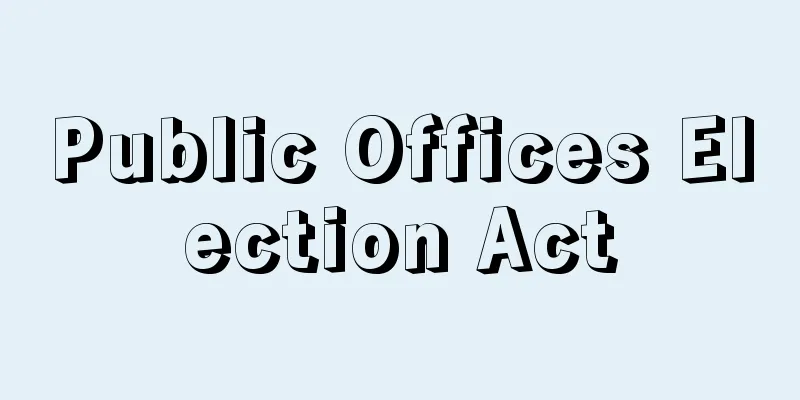Public Offices Election Act

|
This law (Law No. 100 of 1950) stipulates the number of seats and the election method for four public offices: members of the House of Representatives, members of the House of Councilors, heads of local government entities, and members of local assemblies. It is a basic law that unified the election laws, which were fragmented under the House of Representatives Election Law and the Local Autonomy Law, in 1950 (Showa 25) based on the principles of the Constitution. The Ministry of Internal Affairs and Communications is in charge of this law. Its purpose is to select public office holders fairly and appropriately and to promote the healthy development of democratic politics. It prescribes the Central Election Commission, the right to vote, the right to be elected, the number of seats, electoral districts, voter lists, election procedures (public notice, date, voting and counting, etc.), requirements for political parties and political organizations, election disputes, election campaigns, penalties, etc. The voting age, which had long been set at 20 years of age or older (for elections for heads and assembly members of local government entities, a residence of at least three months is required), was lowered to 18 years of age in June 2016 (Heisei 28), bringing Japan in line with other countries. The right to be elected is stipulated to be 30 years of age or older for members of the House of Councillors and prefectural governors, and 25 years of age or older for all others. (1) Those who have been sentenced to imprisonment or more and are currently serving their sentences, (2) Those who have been sentenced to bribery or other crimes for less than five years, and (3) Those who have been sentenced to imprisonment or more for an election offense and are on suspended sentence are ineligible to vote or to be elected. In 1982 (Showa 57), a closed list proportional representation system was introduced for elections of House of Councillors members, and in 1994 (Heisei 6), elections of House of Representatives members were changed to a mixed system of single-seat districts and proportional representation, and the move towards party elections progressed. The Public Offices Election Law has been amended many times to keep up with the times. In order to ensure the fairness and equality of elections, door-to-door visits and the provision of food and drink have been consistently prohibited or restricted, while a permanent voter list system was established (1966) in which once registered, voters' names remain valid unless they die or move, and the chain of responsibility system has been strengthened several times (1952, 1962, 1975, 1981, 1994, etc.). In order to provide more opportunities to vote and improve the low voter turnout, measures such as the establishment and expansion of absentee voting (1975), overseas voting (2000), and early voting (2003) systems, and the extension of voting hours (1998) were also taken, and the distribution of manifestos that clearly state campaign promises was also lifted (2003). Improved transportation facilities led to a shortening of the election campaign period (1983), the implementation of television broadcasting of the election (1969), and the establishment of regulations on symbol-based voting (1970). In response to the lack of candidates for assembly members and mayors in depopulated areas, the government has made progress in publicizing elections, with the public covering the costs of campaign vehicles and campaign flyers and posters for prefectural and city assembly members (1992) and town and village mayors and town and village assembly members (2020). However, despite the population change, the electoral districts and seats for both the House of Representatives and the House of Councillors have been left untouched, resulting in a significant imbalance in the value of one vote, and the Supreme Court has repeatedly ruled that this is "unconstitutional" or "unconstitutional" since 1976. The Diet has amended the Public Offices Election Act and adjusted the number of seats for electoral districts each time, but it is far from making a fundamental correction and is lagging behind. Although the ban on election campaigns using the Internet was lifted in 2013, the debate over lifting the ban on online elections has taken more than 10 years, and the reality is that Japan's electoral system is lagging far behind the rapid advances in information technology. [Takeshi Yano November 13, 2020] [References] | | | | | |Single-seat | | | | | | | | | | | |Source: Shogakukan Encyclopedia Nipponica About Encyclopedia Nipponica Information | Legend |
|
衆議院議員、参議院議員、地方公共団体の首長、地方議会議員の四つの公職について定数や選挙方法などを定めた法律(昭和25年法律第100号)。衆議院議員選挙法や地方自治法などでばらばらであった選挙法制を、憲法の理念に基づき、1950年(昭和25)に統一した基本法である。所管官庁は総務省。公職就任者を公明・適正に選び、民主政治の健全な発達を期す目的がある。中央選挙管理会、選挙権、被選挙権、議員定数、選挙区、選挙人名簿、選挙手続(公示・告示、期日、投・開票など)、政党や政治団体の要件、選挙争訟、選挙運動、罰則などについて規定。長く20歳以上の日本国民(地方公共団体の長・議員選挙では3か月以上の居住が必要)としてきた選挙権を2016年(平成28)6月から18歳以上に引き下げ、諸外国と足並みをそろえた。被選挙権については参議院議員と都道府県知事は30歳以上、その他は25歳以上の日本国民と規定。(1)禁錮(きんこ)以上の刑に処せられ執行中の者、(2)収賄罪などで刑に処せられて5年未満の者、(3)選挙犯罪で禁錮以上の刑に処せられ執行猶予中の者、は選挙権、被選挙権ともに保有できない。1982年(昭和57)から参議院議員選挙に拘束名簿式比例代表制を導入し、1994年(平成6)から衆議院議員選挙を小選挙区比例代表並立制に改め、政党選挙化が進んだ。 公職選挙法は時代にあわせて改正を繰り返してきた。選挙の公平性や平等性を保つため一貫して戸別訪問や飲食物の提供などを禁止・制限する一方、死亡や転居しない限りいったん登録すると効力をもち続ける永久選挙人名簿制度を確立(1966年)し、たびたび連座制を強化(1952、1962、1975、1981、1994年など)した。投票機会を広く提供し低迷する投票率を改善するため不在者投票(1975年)、在外投票(2000年)、期日前投票(2003年)制度の整備・拡充、投票時間の延長(1998年)などの措置がとられ、公約を明確に示すマニフェスト配布も解禁(2003年)された。交通の便の向上で選挙運動期間が短縮(1983年)され、テレビ政権放送の実施(1969年)や記号式投票の規制整備(1970年)が進んだ。過疎地の議員や首長のなり手不足に対応し、都道府県議会議員・市議会議員(1992年)や町村長・町村議会議員(2020年)の街宣車や選挙運動用ビラ・ポスターの費用を公費負担する選挙の公営化も進んだ。ただ人口変動にもかかわらず、衆参両院議員の選挙区・定数が手つかずのまま放置され、1票の価値に著しい不均衡を生じ、最高裁判所は1976年以降「違憲」「違憲状態」との判決を何度も出している。国会はその都度、公職選挙法を改正し選挙区の定数を調整しているが、抜本的是正にはほど遠く、後手に回っている。インターネットを利用した選挙運動は2013年に解禁されたが、ネット選挙の解禁論議は10年以上の時間を費やし、日本の選挙制度は急速な情報技術の進展から大きく後れをとっているのが実態である。 [矢野 武 2020年11月13日] [参照項目] | | | | | | | | | | | | | | | | | |出典 小学館 日本大百科全書(ニッポニカ)日本大百科全書(ニッポニカ)について 情報 | 凡例 |
<<: Ban from public office - kōshoku tūhō
>>: Farming and weaving - Farming and weaving
Recommend
《Türk yurdu》(English spelling) Turkyurdu
...Turanism, which was born among the Turkish peo...
Picturesque (English spelling)
An aesthetic concept used mainly in 18th-century E...
Uiro mochi - Uiro mochi
...It is said that after the Chin Clan presented ...
Frémont, John Charles
Born January 21, 1813 in Savannah, Georgia [Died] ...
Coolidge, William Augustus Brevoort
Born: August 28, 1850, New York, New York, United ...
Rapunzel (English spelling)
It refers to Nojisha. A European folk tale. The st...
Hārūn al‐Rashid
766‐809 The fifth caliph of the Abbasid dynasty. R...
Stingray - Akaei
A general term for a family or genus of the order...
Literature - bungaku (English spelling) literature English
The simplest explanation of literature is that it...
Ghassoul - Gassoul
…The present name is Yorghan Tepe. However, the s...
Agejitomi
〘noun〙 A shutter that has a hinge at the top so th...
SR Processing - SR Kakou
…Stain-resistant and wrinkle-resistant [Sakamoto ...
Mental Illness - Seishin Ijyou
〘 noun 〙 A state in which one's mental balance...
Garnierite (garnierite)
A hydrous nickel-magnesium silicate mineral, a mem...
Asturias (English spelling) Asturias, Miguel Ángel
Born: October 19, 1899 in Guatemala City Died: Jun...






![Allstate Insurance [company] - Allstate Insurance](/upload/images/67cfdfceb06e7.webp)


